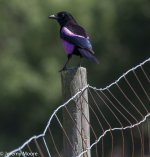jerry12953
Well-known member
This was first reported by a non-birder as a rosy starling. As I was in the area I thought I'd go and take a look. Imagine my surprise when I saw this!
My first view was against bright sunlight and the whole bird appeared to be glowing red. In normal light it appeared to be a bright pink and black bird, but in the photo you can see that it is iridescing blue as normal on its (?) secondaries, but I think there's a hint that other areas are showing a red iridescence. There have been suggestions that industrial chemicals may have been involved but it's really not that type of area (rural Pembrokeshire).
Any ideas what could have caused it?

My first view was against bright sunlight and the whole bird appeared to be glowing red. In normal light it appeared to be a bright pink and black bird, but in the photo you can see that it is iridescing blue as normal on its (?) secondaries, but I think there's a hint that other areas are showing a red iridescence. There have been suggestions that industrial chemicals may have been involved but it's really not that type of area (rural Pembrokeshire).
Any ideas what could have caused it?





